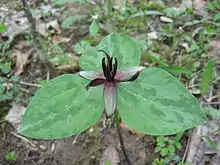Trillium stamineum
Trillium stamineum, the twisted trillium,[4] also known as the Blue Ridge wakerobin,[5] is a species of flowering plant in the family Melanthiaceae. It is native to the southeastern United States, in Alabama, Mississippi and Tennessee.[6] Its natural habitat is calcareous woodlands.[7]
| Trillium stamineum | |
|---|---|
 | |
| flower and foliage | |
| Scientific classification | |
| Kingdom: | Plantae |
| Clade: | Tracheophytes |
| Clade: | Angiosperms |
| Clade: | Monocots |
| Order: | Liliales |
| Family: | Melanthiaceae |
| Genus: | Trillium |
| Species: | T. stamineum |
| Binomial name | |
| Trillium stamineum | |
| Synonyms[3] | |
| |
In 1901, Harbison compared T. stamineum to T. sessile.[8] The former is distinguished by its pubescent stem, unusual petals, long erect stamens, and very short filaments.
Description
Trillium stamineum is a perennial herbaceous plant that spreads by means of underground rhizomes. The plant has three sessile bracts (leaves) arranged in a whorl about a pubescent scape (stem) that rises directly from the rhizome 15 to 30 cm (5.9 to 11.8 in) high. The ovate leaves, 6.3 to 7.6 cm (2.5 to 3.0 in) long by 3.3 to 5 cm (1.3 to 2.0 in) wide, are bluish-green with strong mottling that fades with age.[4]
T. stamineum flowers between March and May,[9] depending on latitude. A solitary flower is carried directly on the leaves. Unlike other sessile-flowered trilliums, the petals spread horizontally (instead of vertically) exposing stiffly erect stamens 16 to 24 mm (0.6 to 0.9 in) long. The dark maroon petals, 1.5 to 2.8 cm (0.6 to 1.1 in) long by 0.3 to 0.6 cm (0.1 to 0.2 in) wide, have a distinctive twist along their major axis. The carrion-scented flower of this species attracts scavenging flies and other insects for pollination.
All flower parts (stamens, filaments, anthers, ovary, stigmas) are purple or dark purple. Even the fruit is purple. In 1975, Freeman described a form that is devoid of purple pigment, which he called Trillium stamineum f. luteum.[10] That name is now regarded as a synonym.
Taxonomy
Trillium stamineum was described by American botanist Thomas Grant Harbison in 1901.[2]
References
- "Trillium stamineum". NatureServe Explorer. NatureServe. Retrieved 16 November 2021.
- "Trillium stamineum Harb.". International Plant Names Index (IPNI). Royal Botanic Gardens, Kew; Harvard University Herbaria & Libraries; Australian National Botanic Gardens. Retrieved 1 April 2023.
- "Trillium stamineum". World Checklist of Selected Plant Families (WCSP). Royal Botanic Gardens, Kew.
- Case Jr., Frederick W. (2002). "Trillium stamineum". In Flora of North America Editorial Committee (ed.). Flora of North America North of Mexico (FNA). Vol. 26. New York and Oxford: Oxford University Press – via eFloras.org, Missouri Botanical Garden, St. Louis, MO & Harvard University Herbaria, Cambridge, MA.
- USDA, NRCS (n.d.). "Trillium stamineum". The PLANTS Database (plants.usda.gov). Greensboro, North Carolina: National Plant Data Team. Retrieved 15 December 2015.
- "Trillium stamineum". County-level distribution map from the North American Plant Atlas (NAPA). Biota of North America Program (BONAP). 2014. Retrieved 3 October 2019.
- Chester, Edward (2015). Guide to the Vascular Plants of Tennessee.
- Harbison, T. G. (1901). "New or little known species of Trillium". Biltmore Botanical Studies. 1 (1): 23. Retrieved 4 October 2019.
- Stritch, Larry. "Twisted Trillium (Trillium stamineum)". United States Forest Service. Retrieved 6 October 2019.
- Freeman (1975), p. 26.
Bibliography
- Case, Frederick W.; Case, Roberta B. (1997). Trilliums. Portland, Oregon: Timber Press. pp. 232–235. ISBN 978-0-88192-374-2.
- Freeman, J. D. (1975). "Revision of Trillium subgenus Phyllantherum (Liliaceae)". Brittonia. 27 (1): 1–62. doi:10.2307/2805646. JSTOR 2805646. S2CID 20824379.
- Shaver, Jesse M. (July 1957). "Some notes on Trillium stamineum Harbison in Tennessee" (PDF). J. Of Tenn. Academy of Science. 32 (3): 169–184. Retrieved 1 February 2022.
